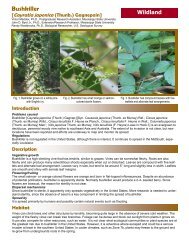RATopic1_95 - Geosystems Research Institute - Mississippi State ...
RATopic1_95 - Geosystems Research Institute - Mississippi State ...
RATopic1_95 - Geosystems Research Institute - Mississippi State ...
You also want an ePaper? Increase the reach of your titles
YUMPU automatically turns print PDFs into web optimized ePapers that Google loves.
Introduction<br />
Invasive species are a widespread and increasing<br />
problem for terrestrial and aquatic ecosystems<br />
in the United <strong>State</strong>s, degrading their biodiversity<br />
and the ecosystem services they provide<br />
to our society. As a result, over the past<br />
decade federal and state agencies and nongovernmental<br />
organizations have begun to work<br />
more closely together to address it.<br />
While awareness of the problem is becoming<br />
more widespread, efforts to address the threat<br />
are often piecemeal and fragmented, and new<br />
tools to deal with the problems are needed. In<br />
particular, the states in the Mid-South Region<br />
(AL, AR, LA, MS, and TN) need assistance in<br />
developing additional capacity, expertise, and<br />
resources for addressing the invasive species<br />
problem.<br />
This report presents progress on a program of<br />
planned research, extension, and regional coordination<br />
for implementation by the <strong>Geosystems</strong><br />
<strong>Research</strong> <strong>Institute</strong> (GRI) of <strong>Mississippi</strong> <strong>State</strong> University (MSU) in collaboration with the U.S. Geological Survey<br />
(USGS). We propose three areas of directed, peer-reviewed research to enhance the management of invasive species:<br />
aquatic invasive plants, developing a National Early Detection and Rapid Response webpage, and the renegade biocontrol<br />
agent, cactus moth (Cactoblastis cactorum). For each area, a program of extension and outreach has been developed<br />
to deliver the information from our research to those who can best make use of the results, both through traditional<br />
printed information and web-based<br />
information solutions. Our current<br />
webpage effort, the Cactus Moth Detection<br />
and Monitoring Network<br />
(www.gri.msstate.edu/cactus_moth),<br />
has been operating for four years and<br />
garnered significant attention as the<br />
one source for pricklypear cactus and<br />
cactus moth location information nationwide.<br />
Our newest webpage is the<br />
Invasive Plant Atlas of the Mid-South<br />
(IPAMS) which is currently available<br />
at www.gri.msstate.edu/ipams. While<br />
USDA CSREES (now NIFA) is funding<br />
the initial program, we have listed<br />
USGS BRD and NBII as partners in<br />
the effort.<br />
Figure 2. Underwater photo of Eurasian watermilfoil (Myriophyllum spicatum) in Noxon<br />
Reservoir, Montana. <strong>Geosystems</strong> <strong>Research</strong> <strong>Institute</strong> staff assisted the Sanders County<br />
(MT) Eurasian watermilfoil Task Force, under the guidance of the U.S. Army Engineer<br />
<strong>Research</strong> and Development Center, with a demonstration control project during the summer<br />
and fall of 2009. Photo by John Madsen.<br />
Figure 1. Ryan Wersal (left) and Dr. David Shaw (right) discuss invasive plant<br />
management while sampling on Noxon Reservoir, Montana. Dr. Shaw, at that<br />
time Director of GRI, came to participate in a demonstration project of controlling<br />
Eurasian watermilfoil in Noxon Reservoir. Dr. Shaw is now Vice President<br />
of <strong>Research</strong> and Economic Development at <strong>Mississippi</strong> <strong>State</strong> University. Photo<br />
by John Madsen.<br />
Specialists in USGS and other entities<br />
that are providing information, perspective,<br />
and/or oversight for the project<br />
are identified as collaborators. The<br />
research addresses invasive species<br />
issues that are often complex and require<br />
long-term cooperation.<br />
2009 USGS Annual Report 5 <strong>Mississippi</strong> <strong>State</strong> University’s <strong>Geosystems</strong> <strong>Research</strong> <strong>Institute</strong>




